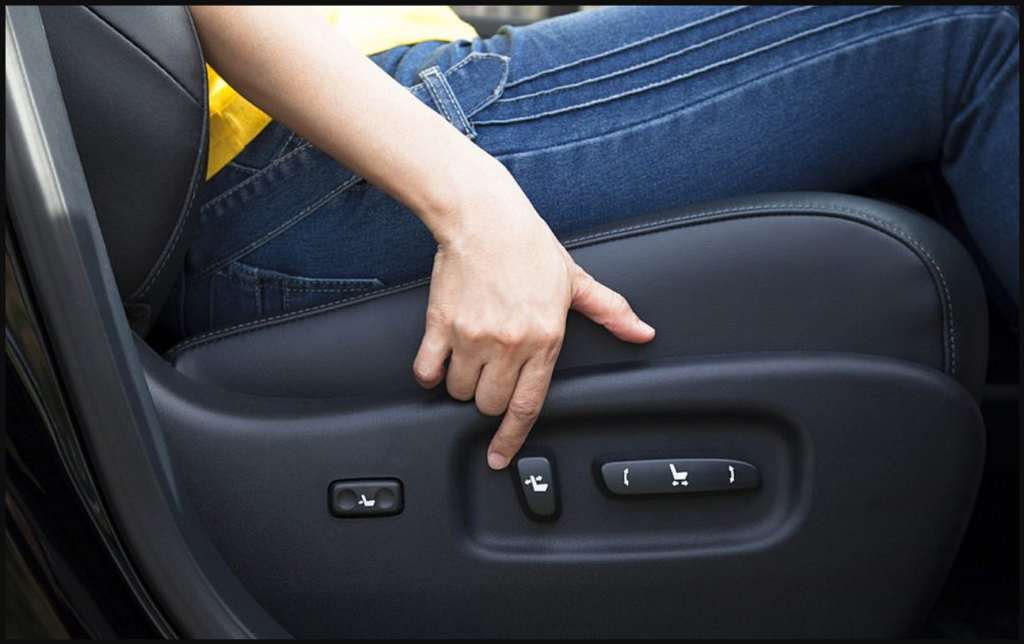Power Seat won’t Move Forward Or Back; Why and How to Fix?
Table of Contents
Why does the Power Seat won’t Move?
here are three potential reasons why a power seat won’t move forward or backward in a car, along with corresponding fixes:
The most common reason:- A faulty Seat Motor or Wiring
The power seat motor or wiring may have malfunctioned due to wear and tear, electrical issues, or damage.

Possible Fix
- First, check the fuse box for any blown fuses related to the power seats and replace them if necessary.
- If the fuses are intact, inspect the wiring harness under the seat for any visible damage or loose connections. Tighten or replace connections as needed.
- Use a multimeter to test the power supply to the seat motor. If there’s no power, trace the wiring back to the source to identify and repair any faults.
- If the motor is faulty, it may need to be replaced. This often requires removing the seat from the vehicle and accessing the motor underneath.
Cause 02. Stuck Seat Track or Mechanism:
Debris, obstructions, or a broken mechanism can prevent the seat from moving along its track.
Possible Fix
- Check under the seat and along the tracks for any objects or debris that may be obstructing movement. Clear away any debris found.
- Lubricate the seat tracks and mechanisms with a suitable lubricant to facilitate smooth movement.
- If the seat track is damaged or broken, it may need to be repaired or replaced. This might involve disassembling part of the seat or seeking professional assistance.
Exploring Interchangeable Seats For The Chevrolet Tahoe: A Guide By Generation
ENGINE RIDES
Cause 03. Control Switch or Module Malfunction
The control switch or module responsible for operating the power seat may be malfunctioning due to electrical issues or wear.
Possible Fix for Control switch or module malfunction
- Test the control switch by trying other functions (e.g., recline, tilt) to see if they work. If only the forward/backward movement is affected, the issue may lie with the switch or associated wiring.
- Inspect the control switch for signs of damage, such as worn contacts or loose connections. Clean or replace the switch as necessary.
- If the control module is suspected to be faulty, it may need to be diagnosed using specialized equipment or replaced by a qualified technician.
Cause 04. Broken or Damaged Seat Transmission Cable
The seat transmission cable, which connects the seat motor to the seat tracks, may have snapped or become disconnected due to wear or excessive force.
Possible Fix
- Inspect the transmission cable for any visible signs of damage, such as fraying or disconnection.
- If the cable is damaged, it will need to be replaced. This often involves removing the seat from the vehicle and accessing the cable mechanism underneath.
- Carefully follow the manufacturer’s instructions or consult a repair manual for your specific vehicle model to ensure proper replacement of the transmission cable.
- After replacing the cable, test the seat to ensure that it moves smoothly along the track without any issues.

Cause 05. Internal Mechanical Failure within the Seat Adjuster Mechanism:
Over time, the internal components of the seat adjuster mechanism, such as gears, bearings, or sliders, may wear out or become damaged, leading to a loss of functionality.
Possible Fix
- Disassemble the seat adjuster mechanism carefully to inspect its internal components for signs of wear, damage, or obstruction.
- Replace any worn or damaged parts, such as gears, bearings, or sliders, with new ones compatible with your vehicle’s make and model.
- Ensure that all components are properly lubricated during reassembly to minimize friction and promote smooth movement.
- Test the seat after reassembly to verify that it moves forward and backward as intended without any issues.
By considering these additional factors, you can conduct a more thorough diagnostic process to identify and address the underlying cause of the power seat malfunction in your car. If you encounter difficulties during the troubleshooting or repair process, don’t hesitate to seek assistance from a qualified automotive technician or repair shop.
How to manually move a power seat?
You can manually adjust the position of a power seat using either the motor winder or by accessing and manipulating the seat mechanisms directly. These methods provide alternatives for adjusting the seat position when electrical assistance is unavailable or malfunctioning.
Method 01. Using the Seat Motor Winder
- Locate the power seat motor, typically positioned at the back left or back right of the seat base.
- Identify the motor winder, which is a small knob or lever attached to the motor mechanism.
- To move the seat forward, turn the motor winder counterclockwise (to the left). To move the seat backward, turn the motor winder clockwise (to the right).
- Apply steady and controlled pressure to the winder to adjust the seat position incrementally.
- Keep in mind that manually operating the motor winder may require some effort, but it allows you to adjust the seat position without electrical assistance.
Why Does The Car Suddenly Smells Like Garbage? And How To Fix It ASAP
ENGINE RIDES
Method 02. Accessing and Manipulating the Seat Mechanisms:
- Gather the necessary tools for removing the seat, including a drill, pliers, scissors, and protective gear such as goggles and an apron.
- Use the drill to remove the bolts or screws securing the seat to the floor of the vehicle. Keep track of the hardware for reassembly.
- Carefully lift the seat from its mounting brackets and place it in a safe and accessible workspace.
- With the seat removed, you’ll be able to access the long shaft of the seat’s mechanisms, which allows for manual manipulation.
- Use pliers to grip and adjust the mechanisms as needed to move the seat forward or backward along its track.
- Exercise caution and precision when manipulating the seat mechanisms to avoid damaging any components.
- Once you’ve adjusted the seat to the desired position, reattach it securely to the vehicle floor using the previously removed bolts or screws.
- Test the seat to ensure that it moves smoothly and securely along its track without any issues.
Manual seat adjustment not working; what to do?
Fortunately, there are methods to resolve this issue without necessarily resorting to a mechanic’s assistance:
Lubricate the Track
- The metal tracks under the seat can get rusty or sticky, especially in older cars or humid climates.
- Use something like WD-40 spray on the tracks to make them slippery.
- This helps the seat move smoothly back and forth.
Check Locking Pins
- Sometimes, the seat gets stuck if the pins that hold it in place aren’t locked properly.
- Just give the seat a good shake or push to make sure those pins are in place.
- Listen for a clicking or popping sound, which means the pins are doing their job.
- This might be all you need to get the seat moving again.
If All Else Fails, Get Help
- If shaking the seat or lubricating the track doesn’t work, it’s time to ask a mechanic.
- They can figure out what’s really causing the problem and fix it safely.
- Sometimes, the issue might be more complicated and need professional attention.
By trying these simple fixes first, you might be able to get your manual car seat unstuck without too much trouble.







